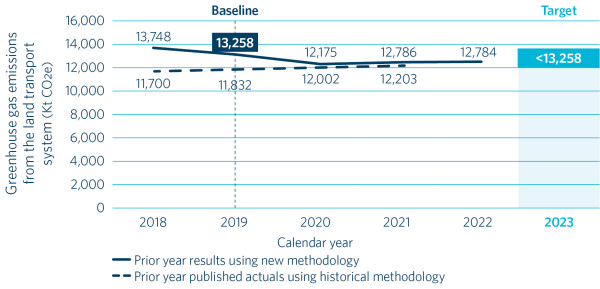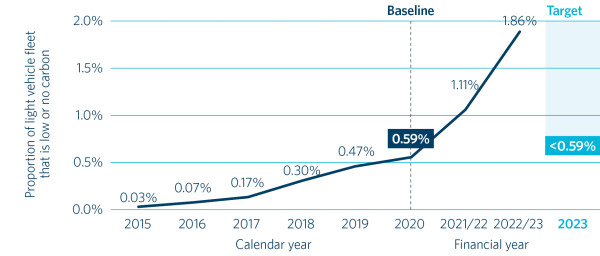The government’s Emissions Reduction Plan (ERP) provides clear direction to transition the country to a low emissions and climate-resilient future. We, along with our transport sector partners, have a vital role to play in delivering the ERP and are working toward the target of a 41 percent reduction in emissions from the land transport system by 2035 (from 2019 levels).
Transport, primarily land transport, is the second largest source of greenhouse gas emissions and the fastest growing source of emissions in Aotearoa New Zealand. To monitor progress toward the ERP goal, we set a target of reducing emissions from the land transport system below 2019 levels. While this target was achieved, emissions from the land transport system increased in 2022/23 compared for 2021/22. Emissions are estimated to remain high over coming years before starting to decrease. Transformational and intergenerational changes are needed to put the country’s transport emissions on the trajectory to a low emissions future, and it will take time to see the results of our interventions.

The Clean Car Discount Scheme paid over $342 million in rebates to New Zealanders who purchased low or zero emissions vehicles with a three-star or higher safety rating throughout the year. Since the scheme began in April 2022, the proportion of light vehicles that were low or zero emissions almost doubled, increasing from 0.98 percent to 1.86 percent. We also improved processes during the year to make it easier and quicker for customers to receive their rebate.

The Clean Car Standard took effect on 1 January 2023. The standard regulates light vehicle importers, with the aim of encouraging a greater supply of low and no emissions vehicle imports. To prepare for the standard, we collaborated with external partners, including industry, to develop a new technology system, operational policies and organisational processes.
We developed a national reduction plan for light vehicle kilometres travelled (VKT) in 2022/23, although it has not yet been published. This plan sets out what we will do to achieve the ERP target in partnership with others.
We’re also working in partnership with local government, iwi/Māori and community representatives to develop VKT reduction programmes for major urban environments. In 2022/23, we began working with our partners to develop VKT reduction programmes in Auckland, Christchurch, Wellington, Tauranga and Hamilton. We expect these plans to be published by 30 June 2024.
Transitioning the public transport bus fleet from diesel-fuelled to zero or low emissions vehicles will help meet the country’s emissions reduction targets. During 2022/23, we engaged with the sector to understand the challenges it is facing and designed a contestable fund to give financial support to public transport authorities as they begin to decarbonise their bus fleets. The contestable fund was announced in April 2023, with the first recipients announced in September 2023.
The Transport Choices Programme will provide people with more transport options and make it easier to travel in ways that are good for everyone and the environment. An indicative package of 46 councils and projects was identified in December 2022 and Waka Kotahi has been working one-on-one with councils across the motu to scope these projects. By 30 June 2023, one had started construction in Auckland and one had been completed.
The increased frequency and intensity of extreme weather events during 2022/23 significantly tested the resilience of the land transport system, disrupted supply chains and isolated communities. While our responses to the severe weather events throughout the year enabled networks and communities to be reconnected as quickly as possible, these events highlight the importance of adaptation and how quickly the country needs to make progress.
The government released the National Adaptation Plan in August 2022 to enable New Zealanders to prepare for and adapt to the impacts of climate change. A critical action in the plan is for us to develop a plan for adapting the land transport system to the reality of a changing climate. Our plan, Tiro Rangi, was published in December 2022. It brings together the resilience work already under way on the transport network and includes new adaptation actions. We’re developing a transition plan to identify the resources we need to deliver the 21 high level actions in Tiro Rangi and have started work on some of those actions.
In 2022/23, we developed and began to deliver an integrated work programme, bringing together all Waka Kotahi activities required under the ERP (including those funded through the Climate Emergency Response Fund), the National Adaptation Plan and the Carbon Neutral Government Programme.
The Carbon Neutral Government Programme aims to accelerate the reduction of emissions within the public sector. The scale, volume and nature of our infrastructure activities and assets mean we have significant embodied carbon emissions, and accurately capturing data on these emissions is a considerable challenge. To collect the information we need to understand our carbon footprint, we continued negotiations with suppliers to update data collection and reporting requirements for existing contracts and included requirements in new contracts. These negotiations are complex and will continue in 2023/24.